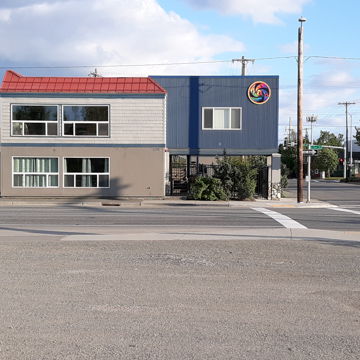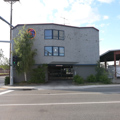Karluk Manor is an initiative operated by the Rural Alaska Community Action Program (RurAL CAP), which developed as one of the Great Society and War on Poverty programs in the mid-1960s. Lyndon Johnson signed legislation that created the community action programs (CAP) in 1965 as part of the Office of Economic Opportunity. Rather than the social programs be administered from Washington, DC, the idea was for each CAP to contain what was called “maximum feasible participation” from local actors and effectively operate with a high level of autonomy. Thus, community action was typically federally funded but locally administered. This particular program was established to combat chronic homelessness in the Anchorage community. Today, RurAL CAP is classified as a private nonprofit for tax purposes.
The Karluk Manor is a facility that is designed to provide “housing first” to underserved Alaskans. Housing first is a method of addressing homelessness by providing permanent housing, rather than temporary shelter, without any preconditions, such as employment, service, or sobriety. In fact, the site is mostly open to Alaskans who long battled alcohol addiction and have typically settled in urban Alaska from one of the state’s rural communities. These are some of the most vulnerable and marginalized populations. The goal is to first provide housing and eventually a level of stability that could pave the way to sobriety.
The site is named for its position along Karluk Street and was, until 2010, a Red Roof Inn. In 2010, RurAL CAP marshalled federal funds to purchase the property for a discounted $1.2 million. Located east of downtown in an area not known for tourists, the Red Roof Inn long struggled to fill its rooms and had deteriorated for several years before RurAL CAP stepped in with an offer to purchase the property. The motel was well-suited to provide an option for those experiencing housing insecurity. Major renovations, designed by DOWL HKM engineers (now DOWL), included heated walkways to prevent hazardous ice build-up, fencing, security cameras, and an elevator. The modern facility features a steel frame and metal paneling, built to withstand the conditions; this was an upgrade from the older motel that had a reputation as low quality. Karluk Manor's exterior was painted grey with red and blue trim. One may discern that it was once a roadside motel, but RurAL CAP has continued to maintain the facility and prevent it from becoming a drab eyesore. Like the older motel, it has retained the two floors of living space. Limited parking for staff is accessed at the street level. Karluk Manor opened in December 2011 with forty-six furnished efficiency units; each included new carpeting, paint, and furniture.
The decision to close the older Red Roof Inn and open Karluk Manor was not without controversy. It joined other social service agencies and homeless shelters such as Bean’s Café and Brother Francis in the Fairview neighborhood. Itself a low-income community, residents of Fairview feared that their neighborhood was becoming a “dumping ground” for the city’s problems. While Anchorage, like many American cities, has continued to struggle with solutions to chronic homelessness, Karluk Manor and other housing first options have had a modicum of success nationwide in provide vulnerable populations with a stable housing alternative.
References
Boots, Michelle Theriault. ‘Success of Karluk Manor Depends on Who You Ask.” Anchorage Daily News, May 28, 2012, adn.com/alaska-news/article/success-karluk-manor-depends-who-you-ask/2012/05/29/.
Demer, Lisa. “Home for Anchorage Street Inebriates Gets Hearing.” Anchorage Daily News, July 18, 2010, adn.com/alaska-news/article/home-anchorage-street-inebriates-gets-hearing-tonight/2010/07/19/.
Demer, Lisa. “Motel is Proposed as Housing for Homeless Alcoholics.” Anchorage Daily News, January 2, 2010, adn.com/alaska-news/article/motel-proposed-housing-homeless-alcoholics/2010/01/04/.
Demer, Lisa. “New Requirement Slow Rebuild of Housing for Inebriates.” Anchorage Daily News, November 28, 2010, adn.com/alaska-news/article/new-requirements-slow-rebuild-housing-inebriates/2010/11/29/.
Demer, Lisa. “Red Roof Inn Plans Prove Divisive.” Anchorage Daily News, January 29, 2010, adn.com/alaska-news/article/red-roof-inn-plans-prove-divisive/2010/01/30/.
Grove, Casey. “Karluk Manor Project to Begin Housing Chronic Alcoholics.” Anchorage Daily News, October 15, 2011, adn.com/alaska-news/article/karluk-manor-project-begin-housing-chronic-alcoholics/2011/10/16/.
Hardenbergh, David. “Karluk Manor Would Take Homeless Off Streets.” Anchorage Daily News, June 25, 2010, adn.com/voices/article/karluk-manor-would-take-homeless-streets/2010/06/26/.
Hopkins, Kyle. “Study: Street Alcoholics Drinking Less After Moving to Karluk Manor.” Anchorage Daily News, October 10, 2013, adn.com/state-of-intoxication/article/study-street-alcoholics-drinking-less-after-moving-karluk-manor/2013/10/10/.
“Karluk Manor.” Rural Alaska Community Action Program, Inc., n.d., https://ruralcap.com/housing/karluk-manor/.
“Karluk Manor.” DOWL, n.d., dowl.com/Karluk-Manor.
“Our View: Red Roof Shelter.” Anchorage Daily News, January 5, 2010, adn.com/voices/article

















